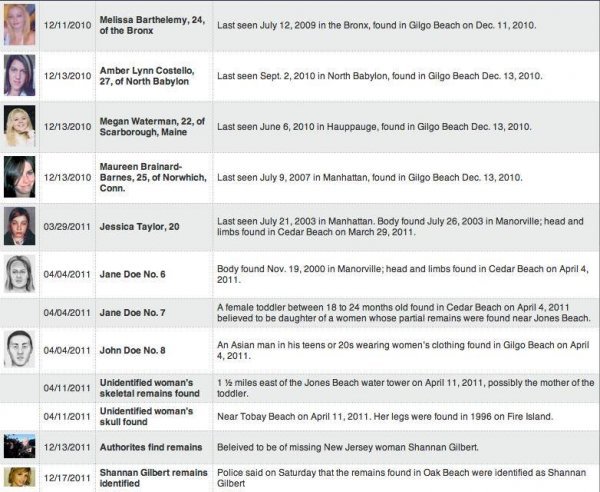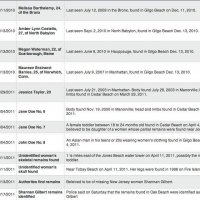It requires signing up to read. At least it did for me.
It let me read it once but when I went back in to try and copy it did the same for me. I'll try again.
Eventually it let me in when I tried accessing it later this evening so I was finally able to get in and copy it all. Here it is below.
Gilgo BeachKillings
A Man Faces Charges in Killings of the Gilgo 4. What About the Other 6?
Rex Heuermann has been charged in four murders, but 10 bodies have been found. Investigators hope fresh leads and new technology may close the cases.
Investigators have interviewed a woman who told of meeting a victim during a swingers' party at Mr. Heuermann’s house in 1996.Credit...Johnny Milano for The New York Times

By
Corey Kilgannon
March 8, 2024
When the authorities announced the arrest of Rex Heuermann last summer in four of the Gilgo Beach serial killings, the relieved families of the slain women stood with them.
But along that desolate stretch of Long Island beach, at least 10 bodies were found. And loved ones of the other victims await answers more than a dozen years later.
“The Gilgo case is still mostly unsolved,” said Lorraine Paulino, 54, who said she met one of the six victims, Karen Vergata, shortly before she disappeared.
To crack the cold case, the task force that formed in early 2022 focused on the so-called Gilgo Four, the most immediately solvable cases, which led to the arrest last summer of Mr. Heuermann, 60.
“When you start a puzzle, you have to start with the most obvious pieces,” the Suffolk County district attorney, Ray Tierney, said in an interview.
The uniform way the bodies were treated bore the hallmarks of a serial killer. Investigators had a strong set of clues including DNA and mobile phone data linking the four bodies to Mr. Heuermann, who has pleaded not guilty to killing the women.
Mr. Tierney, who helped lead the investigative task force, said it would now turn to the cases of the other six victims. But connecting those remains to Mr. Heuermann or anyone else will be tougher. They are colder cases with fewer clues and more random characteristics than the Gilgo Four.
The six victims were found dispersed along several miles, compared with the comparatively neat grouping of the Gilgo Four along a quarter-mile. Three remain unidentified. Four were dismembered. Clues like DNA, phone records and life details are scant.
Still, investigators hope that recent advances in DNA technology that became key in charging Mr. Heuermann can help solve these six cases that have stumped investigators for 13 years.
Image
Ray Tierney, the district attorney of Suffolk County, said that every death is being investigated without preconceptions.Credit...Bing Guan for The New York Times
Many hundreds of tips to the police have poured in since the arrest of Mr. Heuermann, who remains in a Suffolk County jail awaiting his next court date on April 17. And investigators have been interviewing detainees in Suffolk and Nassau County jails who may have worked as escorts. Of 168 interviewed, 15 have yielded information considered relevant enough to pass on to investigators, said the Suffolk County sheriff, Errol Toulon Jr.
Relatives and friends hope that the re-energized investigation and the explosion of media interest from Mr. Heuermann’s arrest may finally help investigators solve the other victims’ cases.
“They owe it to the girls and their families,” said Ms. Paulino, a Long Island nurse. Suffolk County detectives have interviewed her about her account of meeting Ms. Vergata at a swingers’ party at Mr. Heuermann’s home in 1996 — after which Ms. Paulino says she saw a distressed Ms. Vergata run out of the house naked.
“To go all those years with no information,” Ms. Paulino said. “You want to see whoever did it pay for it.”
Mr. Tierney seemed to hint at progress.
“I can say that what we made public is an infinitesimally small fraction of the work we’ve done” on the case overall, he said.
Remains of all 10 victims — eight women, a man, and a little girl — were found around the midpoint of a 15-mile stretch of Ocean Parkway running east from Jones Beach. All the identified women had worked as escorts.
The Gilgo Four, who were discovered in December 2010 along a desolate oceanfront, seemed to be the prey of a serial killer: four young, petite women dumped within a quarter-mile within three years of being found.
Their remains were complete and bound with burlap, belts and tape, which helped to trap human hairs that prosecutors used for DNA evidence to connect the bodies to Mr. Heuermann.
“They were deposited in the same manner, in the same general location, and there were four burner phones used in the same way in all four deaths” to contact the victims, among other similarities, Mr. Tierney said.
But the other six sets of remains, found in early 2011, were disposed of differently. Body parts of two of the dismembered victims were found not only along Gilgo Beach, but in the same wooded area about 45 miles east in Manorville.
The other six bodies disappeared as long ago as the mid-1990s, when mobile phones and internet use were rare — along with the clues they leave. Their remains were exposed to the elements for more than a decade.
Still unidentified are an Asian male found wearing women’s clothing, a woman referred to as Peaches because of a tattoo and her toddler daughter left in a blanket, wearing gold jewelry and bearing no signs of trauma.
Image
Investigators hope that advances in DNA technology will lead to breakthroughs in the six unsolved deaths.Credit...Johnny Milano for The New York Times
While the Gilgo Four remained in touch with their families up to their disappearance and were identified within weeks of discovery, the three other women whose identities are known had lost touch with theirs for years.
During the first decade of the investigation, DNA matches remained scant for the six bodies. Only one was identified, Jessica Taylor, who had disappeared at age 20 in 2003.
In recent years, advances in DNA technology helped investigators identify two more victims, Valerie Mack and Ms. Vergata.
DNA strides also helped connect Mr. Heuermann to the Gilgo Four bodies from withered strands of hair found with the four sets of remains, prosecutors say. “We’re hoping to use the same methodology” on the other six, Mr. Tierney said.
Victims’ families endured a case stalled by scandal, corruption and political infighting, amplified by a constant media circus. They also complained for years that investigators ignored them, but the families seem to have a closer relationship with the current investigators now.
Edwin Mack, a retired engineer from South Jersey, last saw his daughter Valerie in 2000 when she went missing at 24. Two decades later, Suffolk County detectives notified him and his wife, JoAnn, that Valerie had been identified as a Gilgo victim through genetic genealogy.
“We think they’re doing an excellent job,” Mr. Mack said, adding that investigators have visited them several times seeking information. “The detectives seem to be quite thorough in their digging, and they have gone into detail with us.”
In 2021, the Macks were able to claim Valerie’s remains, which are now cremated and kept in a container next to her framed photo. In 2022, they held a memorial on their back deck.
“She has finally been brought home after all these years,” Mr. Mack said.
The Gilgo investigation started with Shannan Gilbert, 24, who in May 2010 disappeared while working as an escort in Oak Beach several miles east of Gilgo and was later found dead there. Her search led to the discovery of the Gilgo bodies, but Suffolk authorities have never deemed her death a homicide or considered her part of the investigation.
Her family’s lawyer, John Ray, said the authorities had prioritized the Gilgo Four to arrest Mr. Heuermann, “but what good is it to the victims whose case not been solved?”
“For every minute they spend on those four, they’re not spending on the other seven cases that need acute attention,” he said.
He accused Suffolk authorities of riding a wave of good publicity from the Heuermann arrest while neglecting the other six cases because of their difficulty, all while maintaining good relations with families “because they don’t want the victims’ families speaking out.”
Mr. Tierney defended prioritizing the four cases as crucial to catching Mr. Heuermann, but he would not discuss whether Mr. Heuermann was a suspect in the other killings. He said that the grand jury empaneled last year will remain in place.
“Each body, each crime scene is different,” he said. “And you look at the evidence as if you have no suspects and work from there.”
A correction was made on
March 8, 2024
:
An earlier version of this article incorrectly said that all Gilgo Beach victims worked as escorts. Investigators have said only that the victims who have been identified worked as escorts.


 www.crimewatchers.net
www.crimewatchers.net


